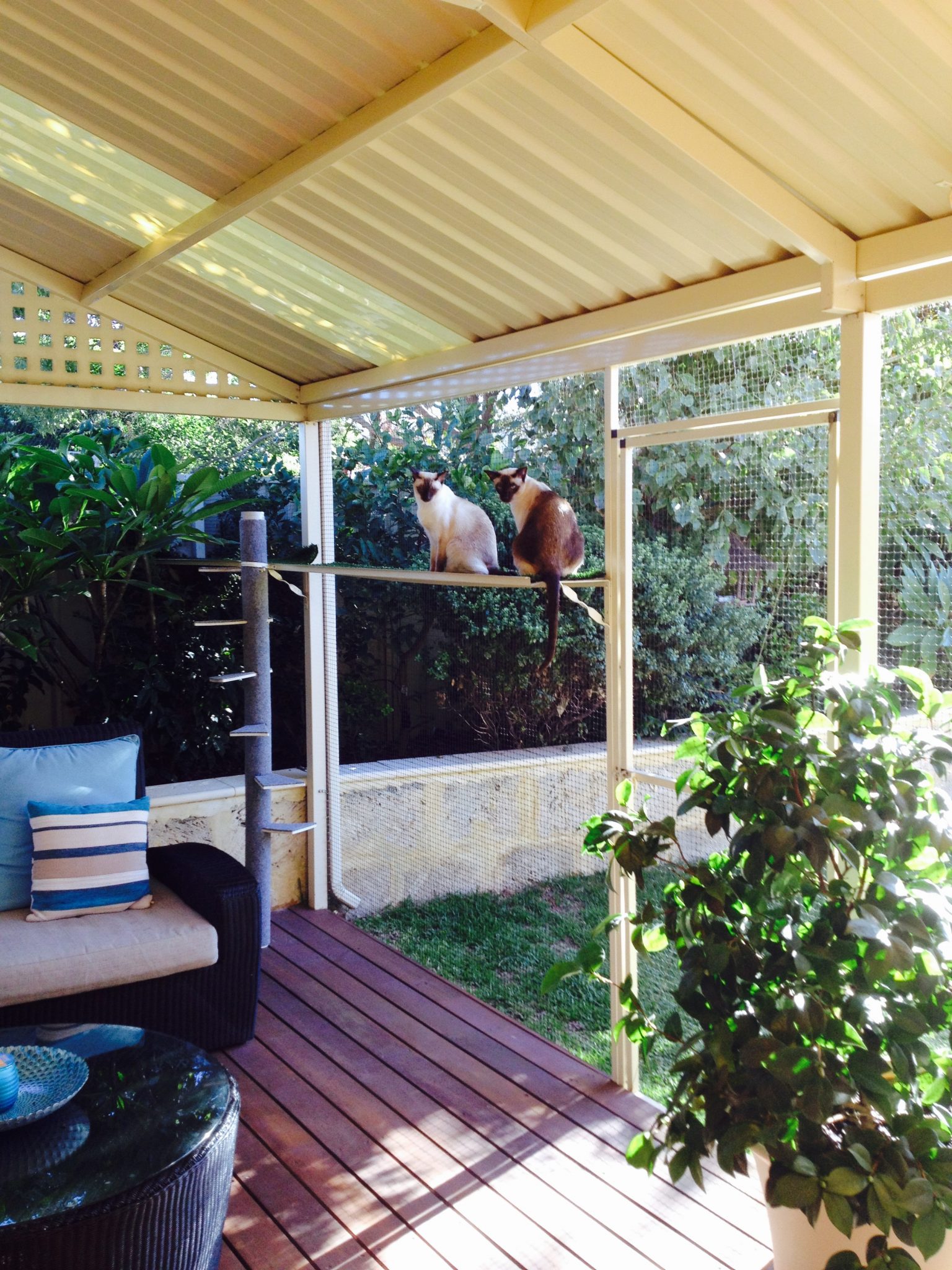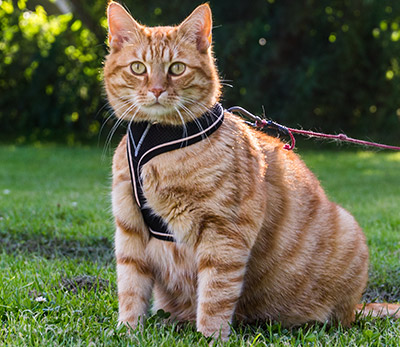
Outdoor enclosures facilitate meeting the cat’s needs
and performance of its normal behaviors.
Photo courtesy of Martine van Boeijen
Deciding if your cat is going to live completely indoors or spend some time outdoors requires careful consideration on your part. First, you need to know the benefits and risks associated with each lifestyle for your cat, and for your family. Then you need to decide what you will be best based on:
- Where you live.
- Health needs of your cat.
- Activity or behavioral needs of your cat.
- Recommendations from your veterinarian.
- Benefits and risks listed below.
Wherever your cat spends most of his time, it is important to make sure he can enjoy natural cat activities such as: scratching, hunting, stalking, and catching prey (real or pretend). This is important to think about because when cats are kept entirely indoors, they can become bored, fearful, and/or anxious if their needs are not met. This can lead to unwanted behavior, such as scratching of furniture or not using the litter box. It is essential to make sure your cat has an enriched environment to meet their needs.
Please speak with your veterinarian to get guidance on how to make sure your cat’s emotional, social, and environmental needs are being met. Once you understand the benefits and risks of an indoor-only or indoor/outdoor lifestyle for your cat, you can minimize the risks and maximize the benefits for your cat.
Indoor Cat

Benefits
- Less risk of injury since your cat is not exposed to outdoor dangers.
- Less risk of poisoning from places and sources that are not monitored.
- Less risk of human abuse or theft.
- Less risk of contagious diseases and parasites.
- Less exposure and risk from predators and wildlife.
- Increased protection from extreme hot and cold temperatures, and dangerous weather conditions.
Risks
- Less able to express normal behaviors of hunting, playing, and scratching that satisfy cats’ physical, social, and emotional needs.
- Increased risk of boredom.
- Lack of stimulation.
- Increased risk of obesity.
- Less likely to have preventive treatments for parasites and contagious diseases because many people think that indoor cats cannot get these diseases.
- Increased risk of stress-associated diseases (lower urinary tract diseases, upper respiratory infections, gastrointestinal diseases).
Indoor/Outdoor Cat

Benefits
- Access to the outdoors allows your cat to participate in normal activities including: development of territory, scratching, choices for toileting, and ability to urine-and scent-mark.
- Increased activity and exercise can improve your cat’s physical, social, and emotional health, and reduce their risk of stress-related behaviors.
- Access to a more stimulating lifestyle addresses all of their senses (smell, taste, touch, hearing, and sight).
- Cats are more likely to get preventive treatments for contagious diseases and parasites.
Risks
- More risk of injury due to exposure from outdoor dangers.
- More risk of poisoning from places and sources that aren’t monitored.
- More risk of danger from wildlife and other animals.
- More risk of human abuse and theft.
- More exposure to contagious diseases and parasites.
- Exposure to hot and cold temperature extremes and dangerous weather conditions.
Creating a Safe Outdoor Environment for Your Cat
The American Association of Feline Practitioners (AAFP) believes an indoor/outdoor lifestyle for cats in a safe environment can keep away most dangers, and provide a more stimulating place for cats to participate in natural activities. Creating a safe outdoor environment can include walking your cat with a harness and leash, having an outdoor enclosure where your cat can roam freely, and having a fenced-in or invisible fence around your property.
If your cat goes outdoors, to improve safety from predators it is recommended that your cat go out during the day and is kept indoors (or in an outdoor enclosure with indoor access) at night. A safe environment can include walking your cat on a harness and leash, having an outdoor enclosure where your cat can roam freely, and having a fenced-in or invisible fence around your property. Young cats and male cats are more likely to engage in activities that increase their risk of injury, and should be monitored more closely.
Indoor-only living is an option, but you will need to work a bit harder to ensure all of your cat’s physical, emotional, and social needs are being met. Speak with your veterinarian for guidance on how to meet all of your cat’s needs including:
- Appropriate play and exercise
- Ability to simulate foraging and hunting
- A safe territory with vertical space
- Appropriate and clean toileting areas

